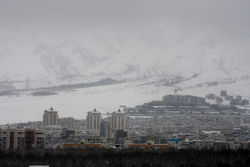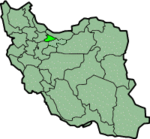Karaj
| Karaj كرج |
|
|---|---|
| — City — | |
 |
|
| Nickname(s): ایران کوچک | |
 Karaj
|
|
| Coordinates: | |
| Country | |
| Province | Alborz |
| Elevation | 1,312 m (4,304 ft) |
| Population (2006) | |
| - Total | 1,377,450 |
| - Population Rank in Iran | 5th |
| Time zone | IRST (UTC+3:30) |
| Area code(s) | 0261 |
Karaj (Persian: کرج, pronounced [kæˈɾædʒ]) is capital of Alborz province; It is situated 20 km west of Tehran, at the foothills of the Alborz mountains.
Karaj had a population of 1,377,450 in the 2006 census, making it the fifth-largest city in Iran after Tehran, Mashhad, Isfahan and Tabriz. (see also List of Iranian cities by population[1]) However, the city is increasingly becoming an extension of metropolitan Tehran.
Karaj is mostly famous because of its academic and educational complexes along with tourist attractions.
Contents |
History

The history of Karaj dates back many centuries. The stone built Zoroastrian fire temple of Takht-e-Rostam from the Parthian era is a testament to this.
The Soleimanieh palace (currently housing a college of Agriculture), the mausoleum of Shahzadeh Soleiman, Imamzadeh Rahman and Zeid Palang Abad-e-Eshtehard are other historical relics of the Karaj area.
During the Pahlavi dynasty era, the Morvarid Palace was constructed in nearby Mehrshahr district, designed by the Frank Lloyd Wright Foundation.
Karaj today
The economical base for Karaj is its proximity to Tehran, where transportation of products between the capital and the Caspian Sea is central. Chemicals, fertilizers and processed agricultural goods are also produced here.
It is connected by freeway, railway to Tehran 40 km east and Qazvin 100 km northwest, and by commuter rail to Tehran subway system (Metro).
Amirkabir dam and small lakes are based here. Karaj's climate is a bit cooler than Tehran and it receives 260 mm of rain annually.
The downtown of Karaj is usually referred to Karaj Square, located hundred of meters to the West of Karaj River and the old Karaj Bridge.
Karaj's major districts include:
- Gohardasht
- Mehrshahr
- Kian-mehr
- Hesarak
- Azimiyeh
- Ouj
- Shahin Vila
- Bonyad
- Baghastan
- Garmdare
- Jahanshahr
- Mesbah: This district is named after the Great Mesbah's family. Sohrab Mesbah, Ahmad Mesbah, Esmaaeil Mesbah, Ebrahim Mesbah, Gholam Hossein Mesbah, Mohsen Mesbah, Mehrdad Mesbah and Mehran Mesbah.
- Mehr Vila
- Dehghan Vila
- Mahdasht
- Fardis
- Vahdat :One Of the Few Government Worker residential For Raja {Rah - Ahan -E -Iran -} .
- Kalak & Hesar
- Islam Abad
- Golshahr
- Zibadasht
- Zob-e-Ahan
- Sasani
- Homayoonvila
- Asara
- Mohammad Shahr
- Mehdi Abad
- Shahrak-e-Khatam
Higher education and research
- Islamic Azad University of Karaj
- Art University
- Faculty of Agriculture and Natural Resources of University of Tehran, located in Karaj
- Center for Research in Agriculture and Nuclear Medicine of Karaj
- Tarbiat Mo'allem University of Tehran at Hesarak
- Razi Vaccine and Serum Research Institute at Hesarak
- Alborz HighSchool(Alborz Colleague)
Transportation
Roads and Freeways
![]() Freeway 2
Freeway 2
![]() Road 32
Road 32
![]() Road 59
Road 59
See also
- Morvarid Palace
References
External links
- Karaj city portal (Persian)
- About Karaj city (Persian)
|
|||||||||||||||||||||
